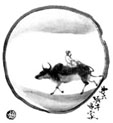Struck by lightening, burned, split apart, holes pecked through and yet this tree keeps growing. Some kinda thing you can never kill.
We’ve been working on “what is the self?” in these parts and that tree sure shows something – the self forgetting itself in inadvertent enthusiasm.
To study the Buddha Way is to study the self; to study the self is to forget the self.
Finally our practice is simple. Studying the self, becoming more and more intimate with the sense of subjectivity itself, suddenly the bottom drops out. The subject falls away. With the subject dropped, there is no object. With a unitive awareness tasted, the work begins to put such “into practice in the midst of the revaluated world,” as D-z put it.
On the cushion, forgetting the self might be no eyes, no ears, no nose. This is negative samadhi. Positive samadhi is forgetting the self in whatever we are doing. Just becoming the doing itself. So in Soto Zen we are rather meticulous about the way of walking, the way of bowing, the way of eating. It seems a bit compulsive at times but the true spirit is to forget the self through giving ourselves completely to whatever we are just doing.
With courage and perseverance, forgetting the self can be actualized. Really, dear reader. And with the dropping of subject and object, the edgy practice of enlightenment is a possibility. I think of the 7th ox herding picture (click here for a bunch of other renditions and various talks on the ox – thanks for your great work, Barry!):
Caution: some in the Soto school disparage breakthroughs and emphasize everyday life. This view might lead to the bracketing, denigrating and splitting off spiritual experience. It is the over-emphasis of application (i.e, practice – but of what? delusion?) and the underemphasis on enlightenment.
It is the flip side of what Lou Nordstrom described in his practice which seems to have over-emphasized enlightenment and the underemphasized application.
When either practice or enlightenment is overemphasized, the necessary ongoing dynamic conversation between them (two things which are not one or two) is impaired or cut off. And it is depressing to live such a divided life.
Dogen (and Katagiri too) did emphasize everyday life, everyday life vivified by actualizing the great earth’s goldenness. Dropping subject and object is wondrous. Practicing that realization in everyday life is difficult.
If subject and object fall away together and rise together, for example, what of the ten thousand things that advance and bug the hell out of us?
In my case, this weekend while settling into sesshin, some thoughts were arising about a meeting I attended recently. The beginnings of sesshin tend to be like that – digesting anything that has been stuck in the craw since the last sesshin. It seemed to me that the people at the meeting didn’t like me very much and I found myself caught in dialogue defending myself and taking some liberties in my little zazen fantasy pointing out their failings.
In studying the quality of subjectivity, I could see that “I” was in a victim relationship (note the passive language above like “thoughts arising”) with the objects – the memories and thoughts about a past experience.
When I remembered that subject and object, I and thou, me and my feelings arise together, I laughed (but not outloud).
Taking responsibility for subject and object provided the correct relationship for them to be quietly and lovingly sloughed off.
For Reflection and Comments (practice period participants, please post comments here):
What is one dharma insight you’ve had recently, and what is one example of how you’ve put it into practice?











